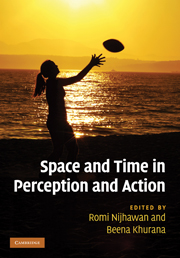Book contents
- Frontmatter
- Contents
- List of contributors
- Acknowledgments
- 1 Space and time: the fabric of thought and reality
- Part I Time–space during action: perisaccadic mislocalization and reaching
- Part II Temporal phenomena: perception
- Part III Temporal phenomena: binding and asynchrony
- Part IV Spatial phenomena: forward shift effects
- 19 The Fröhlich effect: past and present
- 20 Approaches to representational momentum: theories and models
- 21 Conceptual influence on the flash-lag effect and representational momentum
- 22 Perceptual asynchronies and the dual-channel differential latency hypothesis
- 23 Paying attention to the flash-lag effect
- 24 Illusions of time, space, and motion: flash-lag meets chopsticks and reversed phi
- 25 Bridging the gap: a model of common neural mechanisms underlying the Fröhlich effect, the flash-lag effect, and the representational momentum effect
- 26 Perceiving-the-present and a unifying theory of illusions
- 27 History and theory of flash-lag: past, present, and future
- Part V Space–time and awareness
- Index
- References
21 - Conceptual influence on the flash-lag effect and representational momentum
from Part IV - Spatial phenomena: forward shift effects
Published online by Cambridge University Press: 05 October 2010
- Frontmatter
- Contents
- List of contributors
- Acknowledgments
- 1 Space and time: the fabric of thought and reality
- Part I Time–space during action: perisaccadic mislocalization and reaching
- Part II Temporal phenomena: perception
- Part III Temporal phenomena: binding and asynchrony
- Part IV Spatial phenomena: forward shift effects
- 19 The Fröhlich effect: past and present
- 20 Approaches to representational momentum: theories and models
- 21 Conceptual influence on the flash-lag effect and representational momentum
- 22 Perceptual asynchronies and the dual-channel differential latency hypothesis
- 23 Paying attention to the flash-lag effect
- 24 Illusions of time, space, and motion: flash-lag meets chopsticks and reversed phi
- 25 Bridging the gap: a model of common neural mechanisms underlying the Fröhlich effect, the flash-lag effect, and the representational momentum effect
- 26 Perceiving-the-present and a unifying theory of illusions
- 27 History and theory of flash-lag: past, present, and future
- Part V Space–time and awareness
- Index
- References
Summary
Introduction
When judging the position of a moving object, human observers do not perceive and memorize the moving object's correct position. There are two known phenomena in judged position errors of a moving object, representational momentum (RM) and the flash-lag effect (FLE), both of which we consider here.
RM was originally reported by Freyd and Finke (1984). Freyd and colleagues displayed a series of still frames to imply the rotation of a rectangle (e.g., Freyd & Finke 1984, 1985; Freyd & Johnson 1987). Observers saw three views of a rectangle at different rotations about its center, with 250 msec display duration with 250 msec interstimulus interval. The fourth rectangle was presented as a probe 250 msec after the third frame presentation. The rotation of the probe was selected from possible positions symmetrically distributed around the actual third position of the rectangle. Observers were asked whether the rectangle in the third frame (the last frame of the motion sequence) was the same orientation as the probe. The results showed that their memory for the third orientation tended to be shifted in the direction of rotation. In other words, the orientation of the probe rectangle had to be rotated slightly further to be judged as being in the same position as the third rectangle. To account for the forward shift of the final position of a stimulus undergoing implied motion, some authors postulate that the dynamics of the representational system follow physical laws, such as momentum (representational momentum; Finke & Freyd 1985; Finke et al. 1986; Freyd 1987; Finke & Shyi 1988).
- Type
- Chapter
- Information
- Space and Time in Perception and Action , pp. 366 - 378Publisher: Cambridge University PressPrint publication year: 2010



